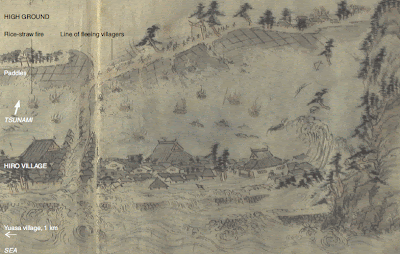On March 11 of this year, an earthquake of this magnitude occurred beneath the ocean floor 43 miles east of the Oshika Peninsula of Japan. The quake and resultant tsunami killed over 15,000 people and resulted in an economic cost of over 200 billion US dollars.
On December 26, 2004, a similar type of earthquake occurred just off the west coast of Sumatra in Indonesia. The resultant tsunami killed over 200,000 people around the Indian Ocean and caused tens of billions of dollars in damage.
Similarly large earthquakes have occurred along offshore subduction zones in 1985 in Mexico, 1964 in Alaska, and 1960 in Chile. They're not especially uncommon.
Queule, Chile, before and after the 1960 earthquake and tsunami
In the late 1980s and through the 1990s, researchers like USGS geologist Brian Atwater started noticing evidence for a very large earthquake along the Pacific Northwest coast. Groves of trees were found submerged into salt water and killed when the land suddenly subsided. Radiocarbon dating and studies of growth rings in the trees narrowed the time of the earthquake to around 1700.
Submerged cedar forest - Willapa Bay, Washington
Painting of 1854 Hiro Village, Japan tsunami
Here's one matter-of-fact account from at 1864 diary entry by James Swan, the first schoolteacher on the Makah reservation at Neah Bay near the Straits of Juan de Fuca...
Billy also related an interesting tradition. He says that "ankarty" but not "Irias ankarty" that is at not a very remote period the water flowed from Neah Bay through the Waatch prairie, and Cape Flattery was an Island. That the water receded and left Neah Bay dry for four days and became very warm. It then rose again without any swell or waves and submerged the whole of the cape and in fact the whole country except the mountains back of Clyoquot. As the water rose those who had canoes put their effects into them and floated off with the current which set strong to the north. Some drifted one way and some another and when the waters again resumed their accustomed level a portion of the tribe found themselves beyond Noothu where their descendants now reside and are known by the same name as the Makah or Quinaitchechat. Many canoes came down in the trees and were destroyed and numerous lives were lost. The same thing happened at Quillehuyte and a portion of that tribe went off either in canoes or by land and found the Chimahcum tribe at Port Townsend.
Now let's review the following image from my previous post.
See that red dot labeled "Subduction zone earthquake (1700)"? Can a magnitude 9+ earthquake and resultant tsunami happen again along this subduction zone? Absolutely! Large sections of this megathrust fault have been basically locked for 300 years or so and there is a chance that it will let go in our lifetimes.
A piece of advice... If you're on a Pacific Northwestern beach or live in a low-lying area, and you feel a large quake with prolonged shaking, run, don't walk, to higher ground!










Very interesting information you provided. I like the part of the Natives being moved by way of water to where they could find land to reside. Thanks! I am writing a paper on this as we speak for my research writing methods class.
ReplyDelete